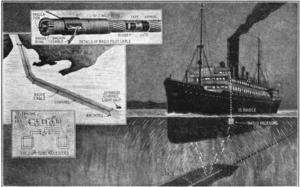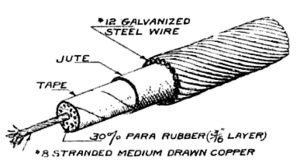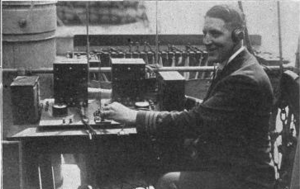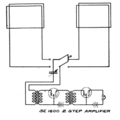Ambrose Channel pilot cable facts for kids
The Ambrose Channel pilot cable was a special underwater cable. It was laid in the Ambrose Channel, which is the main shipping path into New York City's big port. This cable helped guide ships safely in and out of the port, especially when the weather was foggy or visibility was poor.
The cable was put in place between 1919 and 1920. However, by the end of the 1920s, newer wireless technology made it unnecessary, so it was removed.
Contents
Why the Cable Was Needed
The Ambrose Channel is the only way for ships to get into and out of the busy Port of New York and New Jersey. This port is very important for trade.
Bad weather, like thick fog, could close the channel for days. Ships had to wait outside the harbor until the weather cleared. These delays cost shipping companies a lot of money. Each hour a ship was stopped could cost thousands of dollars. This cable was designed to solve that problem.
How the Cable Worked
The Ambrose pilot cable was a strong cable with a single wire inside. It lay on the bottom of the channel, acting like a very long radio antenna. The cable started at Fort Lafayette (near the Verrazano-Narrows Bridge). It stretched 16 miles along the Ambrose Channel to the Lightship Ambrose out at sea.
A generator at Fort Lafayette sent electricity through the cable. This created an invisible electromagnetic field around the cable. Ships could detect this field from about a thousand yards away. The electricity was also set up to send the word "NAVY" in Morse code.
How Ships Used the Cable
Ships had two special induction coils, one on each side. These coils picked up the signal from the cable. The signal then went through an amplifier and into a headset, like headphones.
By switching between the coils, the ship's crew could compare the signal strength on each side. If the signal was stronger on one side, the ship was too far that way. To stay on course, the ship would steer to keep the signal strength equal on both sides. This way, they could follow the cable exactly.
Developing the Idea
The idea for the pilot cable came from earlier inventions. In 1882, A. R. Sennett patented using an underwater cable to talk to a ship. Around the same time, Charles Stevenson patented a way to guide ships over an electric cable.
The method became practical when Earl Hanson improved early vacuum tube circuits. These tubes could make the weak signal from the cable strong enough to be useful.
Robert H. Marriott, a radio expert, did early tests with underwater cables for the Navy. His tests were successful. This led to more development at the Naval Submarine Base New London. A. Crossley, another radio expert, installed a longer test cable. He tested it with both wooden and steel ships, and both could follow the cable easily.
Installing and Testing the Cable
After the successful tests, the Navy decided to install a full-size cable in Ambrose Channel in late 1919. The first attempt had problems. The cable broke in many places during installation. This made it unusable.
Engineers then tested different types of cable to find a stronger design. They ordered a new, improved cable from a company in Boston.
Laying the New Cable
The new cable arrived in New York on July 31, 1920. Before it could be laid, three other telegraph cables already in the channel had to be lifted. The pilot cable was then laid underneath them.
The installation was finished on August 6, 1920. Tests showed that everything worked correctly. The Navy tested the cable with the tugboat USS Algorma.
Public Demonstration
From October 6 to 9, 1920, the Navy held a public demonstration. They invited shipping companies, pilots, and other experts to try out the cable on the destroyer USS Semmes. The ship's windows were covered so the captains had to navigate only by listening to the cable's audio signals.
The demonstration was a big success. People were very impressed. Newspapers called it a major breakthrough for marine travel and a great safety tool for shipping.
Why the Cable Was Important
The cable was seen as a way to help ships:
- Make a good landfall (find their way to shore) in bad weather.
- Guide ships into the harbor.
- Lead ships through narrow channels.
- Warn ships about dangers.
- Help ships stay on a straight course, saving fuel.
In 1922, a magazine called Radio World said the cable had been successful for its first two years. Another magazine, Radio Broadcast, praised the money saved and how easy it was to use.
The cable itself cost about $50,000, paid for by public funds. The listening equipment for each ship cost $1,200. This was much less than the thousands of dollars ships lost from delays. People believed that navigation cables would become common for both ships and even aircraft.
Why the Cable Disappeared
Despite the excitement, the Ambrose Channel pilot cable was not widely used by commercial ships. Some people wanted to extend it further, but this never happened.
New technology quickly made the pilot cable old-fashioned. By 1929, ships were navigating the channel without using the cable.
New Technologies
The main reason the cable became obsolete was the improvement of radio direction finding and radio beacons. Radio beacons are like lighthouses, but they send out radio signals instead of light. Ships can "see" these signals in any weather.
The first successful radio beacons for fog signals were set up near New York in 1921. By 1924, there were many stations and hundreds of ships with the right equipment. By 1930, experts said that "wireless aids" (radio technology) had replaced the leader cable.
Today, ships use even more modern tools like radar, GPS, and lighted buoys to navigate Ambrose Channel.
Legacy
Earl Hanson, one of the key people who helped design the Ambrose Channel cable, thought it was just the beginning. He imagined radio cable technology guiding aircraft and even cars.
The Ambrose Channel cable was eventually removed. It was later used in tests for an early system to help planes land automatically. However, it didn't work well for that either. Other wireless systems proved to be better.
See Also
Images for kids





